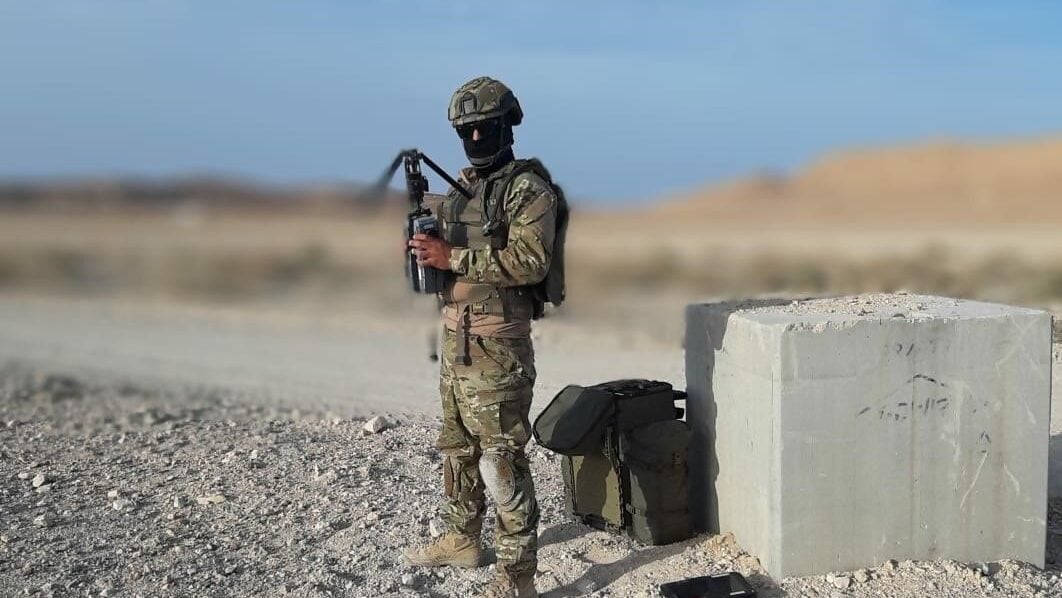After use in combat, Rafael looks to future for Spike FireFly loitering munition

A soldier stands with an Israeli-made Firefly drone. (Credit: Rafael)
JERUSALEM — As part of last week’s operation in the West Bank, Israel for the first time used a weapon known as the Spike FireFly — a small loitering munition produced by Rafael Advanced Systems that can be packed in a backpack and taken into an urban warfare environment.
While the IDF would not elaborate beyond what is already reported in Hebrew media, this appears to be the first operational use of the weapon. Walla media in Israel reported that the army may now equip units with thousands of these Firefly systems, having now passed the first operational use test.
Firefly is the kind of system the IDF seems increasingly interested in, particularly for urban combat. The weapon, which is shaped like the size of a milk carton, is placed on its end, armed with a munition and battery and then takes off vertically. It is guided by an operator using a tablet with an interface designed to be used easily by dismounted infantry. With fifteen minutes of flight time, it is designed for non-line-of-sight operations in an urban area, where snipers or other adversaries might tie down a platoon.
“We describe it as micro loitering munition as part of [the] Spike family” Rafael’s Tzvi Marmor, Vice-President and head of Rafael’s Precision Tactical Weapons Directorate, told Breaking Defense in an interview after the Jenin operation.
The Spike family, in use by 42 countries around the globe, is a large group of systems Rafael makes, including the Spike NLOS that has a range up to 32km down to the smaller Spike SR, with a range of 2km.
The larger Spike systems fit into the anti-tank type of missile framework, whereas Firefly is for taking out personnel, soft vehicles, like jeeps, or equipment. Its short range makes it useful in built-up urban areas where soldiers are in alleyways and enemies might be around a corner — the kind of operation seen last week in Jenin. (Marmor would not comment on whether FireFly was used in the Jenin operation, which has drawn strong condemnation from the UN.)
The system, hovering over a city, can give soldiers situational awareness and home in on a target. It uses the same technology as other Spike and Rafael systems, meaning it has automatic target recognition and uses AI. It can also land and have its battery swapped out, or swap out the payload for another battery, doubling its flight time to 30 minutes.
Rafael says it uses a “directional or omni-directional warhead, suitable for the arena of urban area.” It can attack at an angle, depending on the height it begins its attack from, meaning it could slam into an open window to take out a sniper or similar threat. It always has a man-in-the-loop that must approve the attack and the system can be called off or abort at the last moment. And while the rotor of the system makes noise, similar to other types of rotor-based drones, in an urban environment the noise will be nullified by the usual sounds of the city. “It is relatively quiet,” Marmor said.
The system was first ordered by the IDF in 2020, but Marmor says the company has been constantly updating and iterating the weapon. That includes lessons learned from other conflicts, such as Ukraine. “We learn about trends, technological trends and what customers want. And if there are things that the system is not ready, then we try to improve them,” he said.
One option could be to put it on vehicles, although Marmor says the system is ideal for dismounted infantry, whereas vehicle-based loitering munitions would usually require a longer range. Rafael has demonstrated its NLOS from Oshkosh JLTVs for instance. (Rafael declined to comment on how survivable the weapon is against the kind of technology used to spook, jam and confront drones and loitering munitions on the battlefield.)
“Today the system has been fielded and is mature and is under operation of the IDF. It is very typical that when we field a system we get a lot of lessons-learned from the soldiers and technical units of the IDF and we implement some of those technical and operational changes into the system. It is much more mature and fielded and combat proven in the IDF” now than when first delivered in 2020, Marmor said.
Rafael has been hoping to export FireFly to customers abroad, a situation that may become easier now that it has been used in combat.
According to Marmor, Rafael showcased FireFly at the US Army Expeditionary Warrior Experiment (AEWE), including a live test for US, Australian and British forces during a “force on force maneuver.” Rafael is also in talks with “several” countries in Europe about evaluating the system, Marmor said, but acknowledged there are no countries on contract yet.
“We believe a few countries will contract significant quantities of systems,” Marmor said.
In many cases Rafael partners with companies abroad. Marmor pointed out that Lockheed Martin is the partner for NLOS in the US, while in Europe, Spike is sold through EuroSpike. If Firefly was ordered in large numbers that would likely be the model abroad as well. “Spike Firefly is a revolution in the infantry platoon warfare. After they will use it, after that they won’t go to battle without it again. It’s not just a buzzword. We will see it in other countries that have real wars.”

